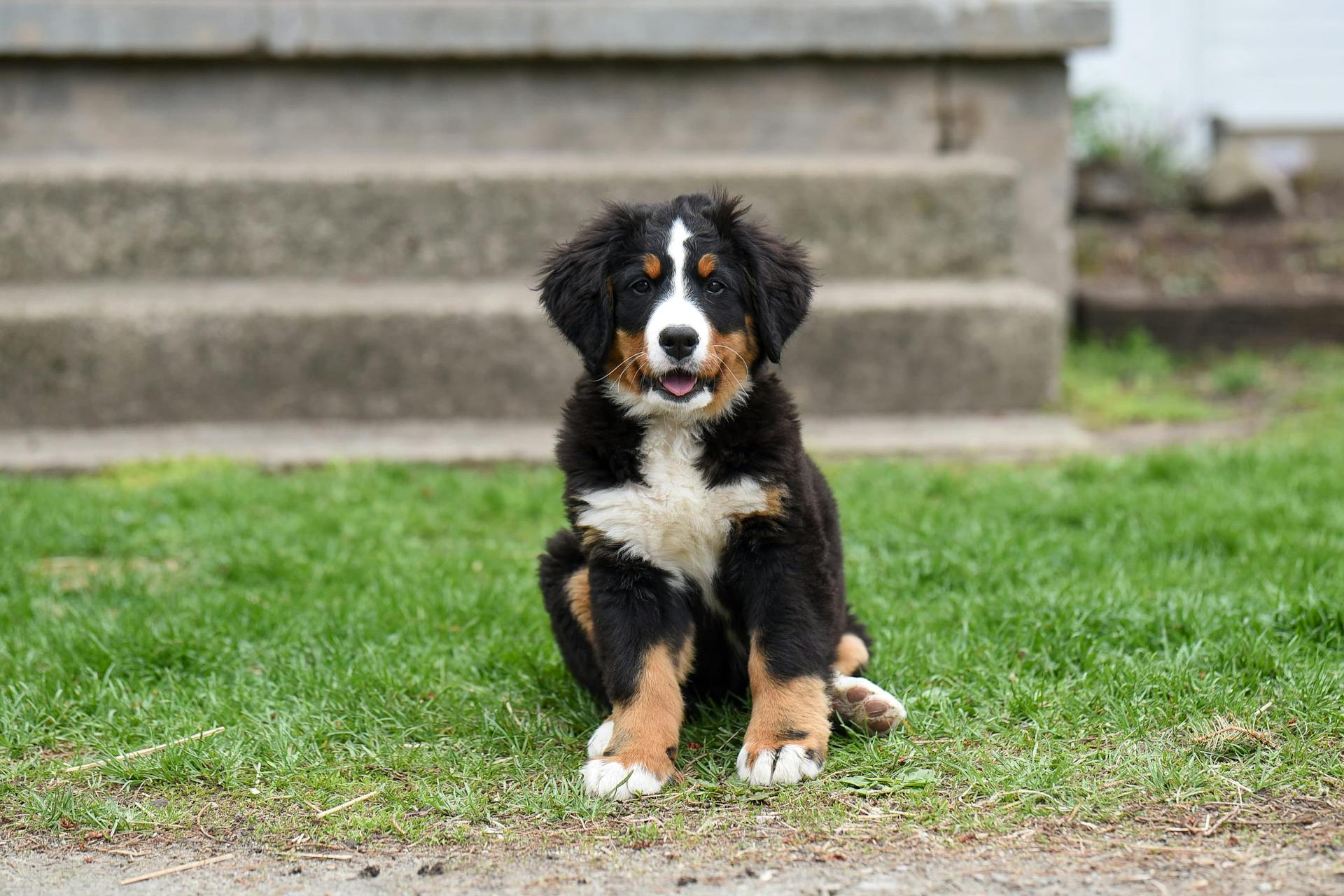
One of the most common eye problems in Bernese Mountain Dogs is progressive retinal atrophy (PRA), a genetic disorder that affects the retina. PRA can cause blindness in affected dogs.
Symptoms of PRA can start as early as 5 years old and may include vision loss, night blindness, and eye discharge.
Ectropion
Ectropion is a common eye problem in Bernese Mountain Dogs, characterized by a "sagging" or "outward rolling" lower eyelid.
A thick, mucoid discharge often accumulates along the eyelid margin, and the eye and conjunctiva may appear reddened or inflamed.
If left untreated, ectropion can cause discomfort and lead to rubbing or pawing at the eye.
Tears may run down the dog's face if the medial aspect of the eyelid is affected, and a brownish staining of the fur beneath the eyes can occur due to pigment in the tear fluid.
Diagnosis of ectropion is usually made on physical examination, but older dogs may require blood and urine tests to rule out underlying causes.
Corneal staining will be performed to assess the cornea and check for any corneal ulceration.
In severe cases, muscle or nerve biopsies may be recommended if neuromuscular disease is suspected.
Treatment for mild ectropion typically involves medical therapy, such as lubricating eye drops and ointments to prevent drying out of the cornea and conjunctiva.
Ophthalmic antibiotics may be prescribed if corneal ulcers develop due to ectropion.
Surgical correction may be necessary for severe cases, where the eyelids are shortened.
With proper treatment, most dogs can enjoy a pain-free, normal life.
However, medical treatment may be life-long, and flare-ups of conjunctivitis can recur.
It's essential to work closely with your veterinarian to develop a diagnostic and treatment plan to help your dog successfully manage ectropion.
Diagnosis and Treatment
Diagnosis of eye problems in Bernese Mountain Dogs typically starts with a physical examination to identify any visible issues. Your veterinarian may also perform corneal staining to assess the cornea and check for corneal ulceration.
Blood and urine tests may be done to rule out underlying conditions that could be causing the eye problem. For example, if your dog is older, your veterinarian may perform these tests to search for hypothyroidism or other underlying causes.
Treatment for mild eye problems often involves medical therapy, such as lubricating eye drops and ointments to prevent dryness and irritation. In some cases, ophthalmic antibiotics may be prescribed to prevent corneal ulcers.
Anterior Uveitis
Anterior uveitis is a serious condition that can lead to irreversible vision loss.
The uvea, which is the part of the eye made up of the choroid, ciliary body, and iris, is affected by this inflammation.
Symptoms of anterior uveitis include redness, discharge, squinting, an oddly shaped pupil, eyeball swelling, excessive tearing, and a cloudy or dull appearance.
The causes of anterior uveitis can be varied, including autoimmune disease, cancer, trauma, metabolic disease, parasites, and fungal, viral, and bacterial infections.
Your veterinarian may run a series of diagnostic tests to narrow down the culprit behind your dog's anterior uveitis.
Treatment will depend on the cause and could include eye drops, eye ointments, and oral medications.
You might enjoy: Lyme Vaccination for Dogs Side Effects
Ectropion Diagnosis
Diagnosing ectropion typically involves a physical examination. If the dog is older, blood and urine tests may be performed to search for an underlying cause.
A physical examination is usually all it takes to make a diagnosis. Corneal staining will be performed to assess the cornea and determine if any corneal ulceration is present.
Muscle or nerve biopsies may be recommended if neuromuscular disease is suspected. This can help identify any underlying issues that may be contributing to the ectropion.
Testing for hypothyroidism and for antibodies against certain muscle fibers may be done if looking for underlying causes. This can provide valuable information about the dog's overall health.
Ectropion Treatment
Ectropion treatment typically starts with medical therapy, which involves using lubricating eye drops and ointments to prevent the cornea and conjunctiva from drying out.
For mild cases, this can be enough to manage the condition.
Ophthalmic antibiotics may be prescribed if corneal ulcers develop due to ectropion.
In more severe cases, surgery may be necessary to shorten the eyelids.
With medical treatment, most dogs can enjoy a pain-free and normal life.
However, lubrication of the eyes is a lifelong process, and flare-ups of conjunctivitis can recur.
Cloudy Eyes Diagnosis and Treatment
A cloudy appearance in your dog's eyes can be caused by several things, including anterior uveitis, a serious condition that can lead to irreversible vision loss.
Your veterinarian will likely run a series of diagnostic tests to narrow down the cause, which could include autoimmune disease, cancer, trauma, metabolic disease, parasites, fungal, viral, or bacterial infections.
If your dog's cloudy eyes are caused by dry eye, also known as keratoconjunctivitis sicca, it's often due to an abnormal reaction of the body's immune system.
Some breeds, such as Yorkshire Terriers and Pugs, are more susceptible to dry eye than others.
Dry eye can be treated with tear-stimulating medications and topical antibiotics, and in severe cases, there are surgical options available to help promote increased tear production.
Your veterinarian will lay out a plan to treat your dog's cloudy eyes if treatment is necessary, and it's essential to watch your dog closely for other symptoms of eye problems, such as increased discharge, squinting, or a change in your dog's eye shape, size, color, or vision.
Health Issues and Breeding
If you're considering bringing a Bernese Mountain Dog into your family, it's essential to be aware of the potential health issues that can arise from irresponsible breeding. Due to the concern of inherited conditions, dogs with severe ectropion requiring surgical correction should not be bred.
A reputable breeder will be honest and open about health problems in the breed and the incidence with which they occur in her lines. They should provide written documentation that the parents were cleared of health problems that affect the breed.
Hip and elbow dysplasia, eye diseases, and heart disease are all common health issues in Bernese Mountain Dogs. Knowing about these conditions beforehand will help you in your search for a breeder.
A responsible breeder will have the parents' health clearances, such as hip and elbow scores from the Orthopedic Foundation for Animals or OVC, or PennHIP scores, and an OFA cardiac clearance.
Here are some common health issues in Bernese Mountain Dogs:
Some health problems, like cancer, can be devastating for Bernese Mountain Dog owners. Unfortunately, there is no genetic testing for these cancers, which can claim many of these dogs, often as young as 4 years of age.
Frequently Asked Questions
Is entropion common in Bernese mountain dogs?
Yes, entropion is a common issue in Bernese Mountain Dogs. This breed is prone to the condition, which affects the lower eyelids.
Sources
- https://www.brooksideanimalhospital.net/client-resources/breed-info/bernese-mountain-dog/
- https://www.akc.org/expert-advice/health/cloudy-eyes-in-dogs/
- https://vcahospitals.com/know-your-pet/eyelid-ectropion-in-dogs
- https://www.embracepetinsurance.com/dog-breeds/bernese-mountain-dog
- https://www.dogster.com/ask-the-vet/bernese-mountain-dog-health-problems
Featured Images: pexels.com

